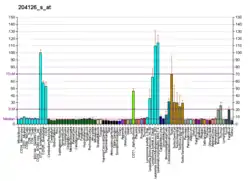CDC45-related protein
CDC45 is a protein that in humans is encoded by the CDC45L gene.[5][6][7][8]
Function
The protein encoded by this gene was identified by its strong similarity with Saccharomyces cerevisiae Cdc45, an essential protein required to the initiation of DNA replication. Cdc45 is a member of the highly conserved multiprotein complex including Cdc6/Cdc18, the minichromosome maintenance proteins (MCMs) and DNA polymerase, which is important for early steps of DNA replication in eukaryotes. This protein has been shown to interact with MCM7 and DNA polymerase alpha. Studies of the similar gene in Xenopus suggested that this protein plays a pivotal role in the loading of DNA polymerase alpha onto chromatin. Multiple polyadenlyation sites of this gene are reported.[8]
Interactions
CDC45-related protein has been shown to interact with:
References
- GRCh38: Ensembl release 89: ENSG00000093009 - Ensembl, May 2017
- GRCm38: Ensembl release 89: ENSMUSG00000000028 - Ensembl, May 2017
- "Human PubMed Reference:". National Center for Biotechnology Information, U.S. National Library of Medicine.
- "Mouse PubMed Reference:". National Center for Biotechnology Information, U.S. National Library of Medicine.
- Saha P, Thome KC, Yamaguchi R, Hou Z, Weremowicz S, Dutta A (Aug 1998). "The human homolog of Saccharomyces cerevisiae CDC45". J. Biol. Chem. 273 (29): 18205–9. doi:10.1074/jbc.273.29.18205. PMID 9660782.
- McKie JM, Wadey RB, Sutherland HF, Taylor CL, Scambler PJ (Sep 1998). "Direct selection of conserved cDNAs from the DiGeorge critical region: isolation of a novel CDC45-like gene". Genome Res. 8 (8): 834–41. doi:10.1101/gr.8.8.834. PMC 310757. PMID 9724329.
- Pollok S, Bauerschmidt C, Sänger J, Nasheuer HP, Grosse F (Jul 2007). "Human Cdc45 is a proliferation-associated antigen". FEBS J. 274 (14): 3669–84. doi:10.1111/j.1742-4658.2007.05900.x. PMID 17608804.
- "Entrez Gene: CDC45L CDC45 cell division cycle 45-like (S. cerevisiae)".
- Kneissl M, Pütter V, Szalay AA, Grummt F (Mar 2003). "Interaction and assembly of murine pre-replicative complex proteins in yeast and mouse cells". J. Mol. Biol. 327 (1): 111–28. doi:10.1016/s0022-2836(03)00079-2. PMID 12614612.
- Kukimoto I, Igaki H, Kanda T (Nov 1999). "Human CDC45 protein binds to minichromosome maintenance 7 protein and the p70 subunit of DNA polymerase alpha". Eur. J. Biochem. 265 (3): 936–43. doi:10.1046/j.1432-1327.1999.00791.x. PMID 10518787.
Further reading
- Leatherwood J (1998). "Emerging mechanisms of eukaryotic DNA replication initiation". Curr. Opin. Cell Biol. 10 (6): 742–8. doi:10.1016/S0955-0674(98)80117-8. PMID 9914182.
- Mimura S, Takisawa H (1998). "Xenopus Cdc45-dependent loading of DNA polymerase alpha onto chromatin under the control of S-phase Cdk". EMBO J. 17 (19): 5699–707. doi:10.1093/emboj/17.19.5699. PMC 1170898. PMID 9755170.
- Shaikh TH, Gottlieb S, Sellinger B, Chen F, Roe BA, Oakey RJ, Emanuel BS, Budarf ML (1999). "Characterization of CDC45L: a gene in the 22q11.2 deletion region expressed during murine and human development". Mamm. Genome. 10 (3): 322–6. doi:10.1007/s003359900996. PMID 10051334.
- Kukimoto I, Igaki H, Kanda T (1999). "Human CDC45 protein binds to minichromosome maintenance 7 protein and the p70 subunit of DNA polymerase alpha". Eur. J. Biochem. 265 (3): 936–43. doi:10.1046/j.1432-1327.1999.00791.x. PMID 10518787.
- Kneissl M, Pütter V, Szalay AA, Grummt F (2003). "Interaction and assembly of murine pre-replicative complex proteins in yeast and mouse cells". J. Mol. Biol. 327 (1): 111–28. doi:10.1016/S0022-2836(03)00079-2. PMID 12614612.
- Clark HF, Gurney AL, Abaya E, Baker K, Baldwin D, Brush J, Chen J, Chow B, Chui C, Crowley C, Currell B, Deuel B, Dowd P, Eaton D, Foster J, Grimaldi C, Gu Q, Hass PE, Heldens S, Huang A, Kim HS, Klimowski L, Jin Y, Johnson S, Lee J, Lewis L, Liao D, Mark M, Robbie E, Sanchez C, Schoenfeld J, Seshagiri S, Simmons L, Singh J, Smith V, Stinson J, Vagts A, Vandlen R, Watanabe C, Wieand D, Woods K, Xie MH, Yansura D, Yi S, Yu G, Yuan J, Zhang M, Zhang Z, Goddard A, Wood WI, Godowski P, Gray A (2003). "The secreted protein discovery initiative (SPDI), a large-scale effort to identify novel human secreted and transmembrane proteins: a bioinformatics assessment". Genome Res. 13 (10): 2265–70. doi:10.1101/gr.1293003. PMC 403697. PMID 12975309.
- Ramachandran N, Hainsworth E, Bhullar B, Eisenstein S, Rosen B, Lau AY, Walter JC, LaBaer J (2004). "Self-assembling protein microarrays". Science. 305 (5680): 86–90. doi:10.1126/science.1097639. PMID 15232106.
- Rual JF, Venkatesan K, Hao T, Hirozane-Kishikawa T, Dricot A, Li N, Berriz GF, Gibbons FD, Dreze M, Ayivi-Guedehoussou N, Klitgord N, Simon C, Boxem M, Milstein S, Rosenberg J, Goldberg DS, Zhang LV, Wong SL, Franklin G, Li S, Albala JS, Lim J, Fraughton C, Llamosas E, Cevik S, Bex C, Lamesch P, Sikorski RS, Vandenhaute J, Zoghbi HY, Smolyar A, Bosak S, Sequerra R, Doucette-Stamm L, Cusick ME, Hill DE, Roth FP, Vidal M (2005). "Towards a proteome-scale map of the human protein-protein interaction network". Nature. 437 (7062): 1173–8. doi:10.1038/nature04209. PMID 16189514.
- Liu P, Barkley LR, Day T, Bi X, Slater DM, Alexandrow MG, Nasheuer HP, Vaziri C (2006). "The Chk1-mediated S-phase checkpoint targets initiation factor Cdc45 via a Cdc25A/Cdk2-independent mechanism". J. Biol. Chem. 281 (41): 30631–44. doi:10.1074/jbc.M602982200. PMID 16912045.
- Masai H, Taniyama C, Ogino K, Matsui E, Kakusho N, Matsumoto S, Kim JM, Ishii A, Tanaka T, Kobayashi T, Tamai K, Ohtani K, Arai K (2006). "Phosphorylation of MCM4 by Cdc7 kinase facilitates its interaction with Cdc45 on the chromatin". J. Biol. Chem. 281 (51): 39249–61. doi:10.1074/jbc.M608935200. PMID 17046832.
- Boskovic J, Coloma J, Aparicio T, Zhou M, Robinson CV, Méndez J, Montoya G (2007). "Molecular architecture of the human GINS complex". EMBO Rep. 8 (7): 678–84. doi:10.1038/sj.embor.7401002. PMC 1905900. PMID 17557111.
- Bauerschmidt C, Pollok S, Kremmer E, Nasheuer HP, Grosse F (2007). "Interactions of human Cdc45 with the Mcm2-7 complex, the GINS complex, and DNA polymerases delta and epsilon during S phase". Genes Cells. 12 (6): 745–58. doi:10.1111/j.1365-2443.2007.01090.x. PMID 17573775.
- Pollok S, Grosse F (2007). "Cdc45 degradation during differentiation and apoptosis". Biochem. Biophys. Res. Commun. 362 (4): 910–5. doi:10.1016/j.bbrc.2007.08.069. PMID 17767920.
External links
- Human CDC45 genome location and CDC45 gene details page in the UCSC Genome Browser.




